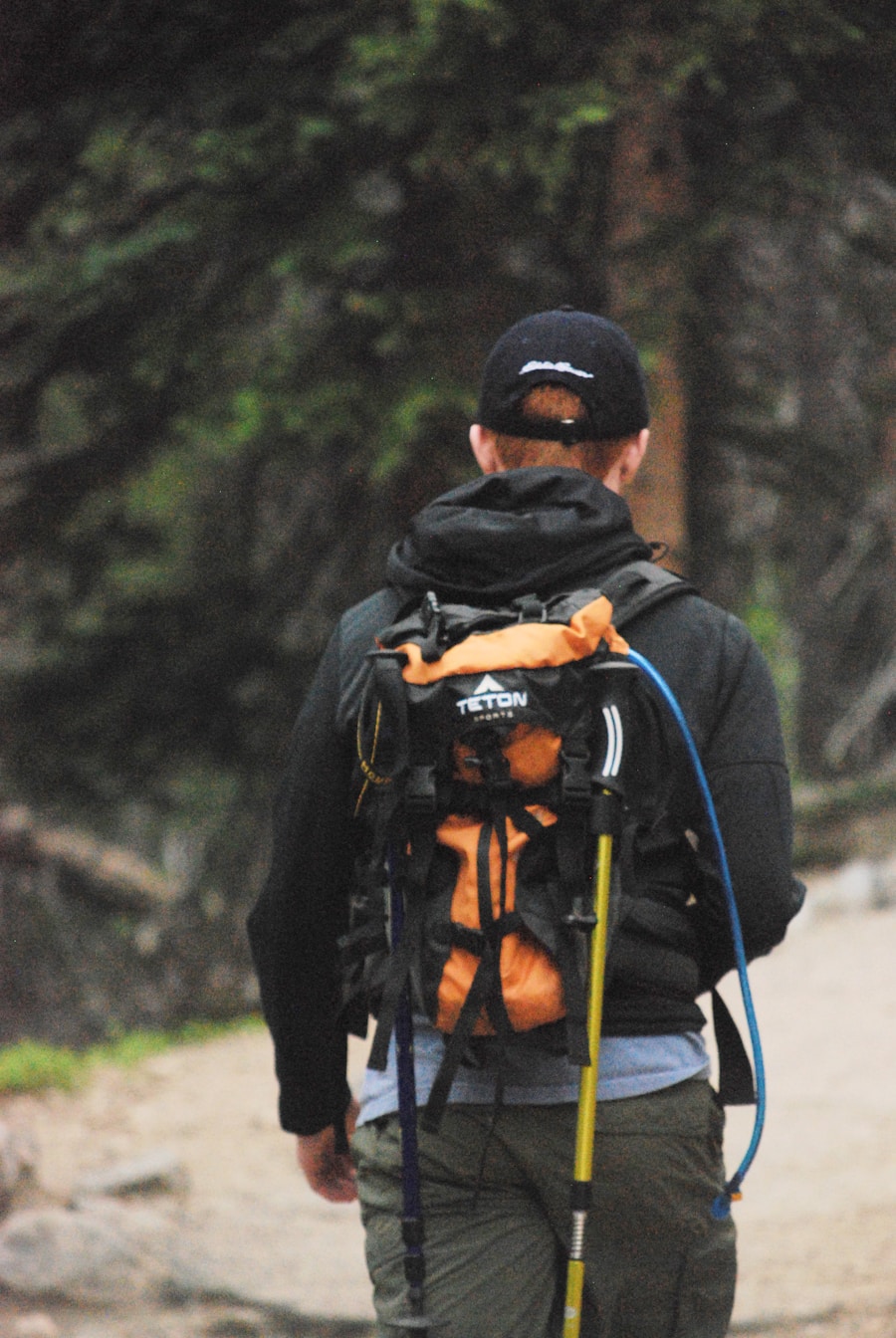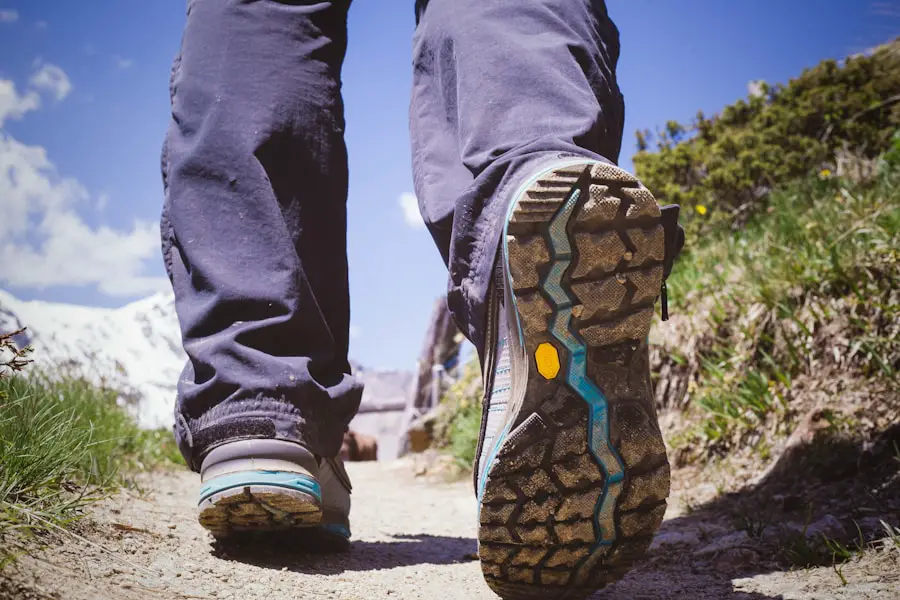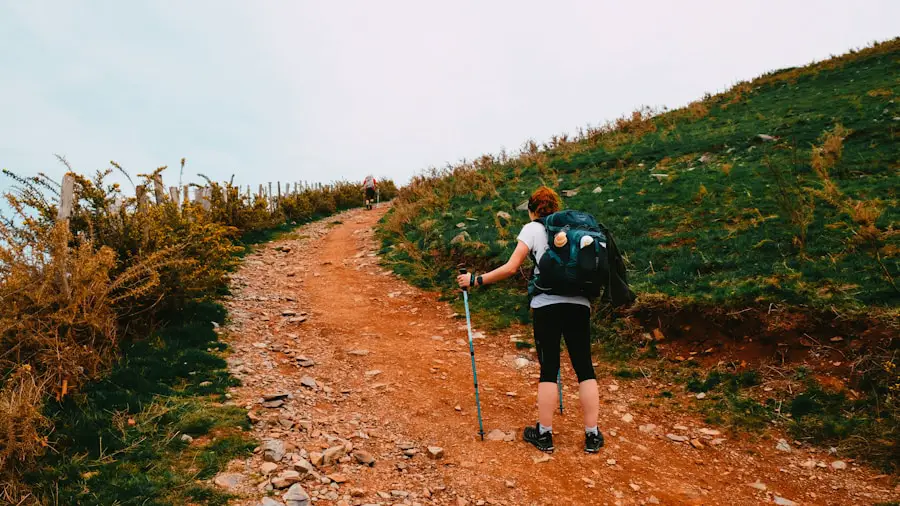Hiking and walking, while both forms of locomotion, present distinct physical challenges that cater to different fitness levels and objectives. Walking, often perceived as a more accessible activity, typically involves flat or gently undulating terrain. It engages the lower body muscles, primarily the calves, quadriceps, and hamstrings, while also promoting cardiovascular health.
A brisk walk can elevate heart rates and improve circulation, making it an excellent choice for individuals seeking to maintain a basic level of fitness or incorporate physical activity into their daily routines. The simplicity of walking allows for easy integration into one’s lifestyle, whether it’s a leisurely stroll in the park or a brisk walk around the neighborhood. In contrast, hiking introduces a more rigorous physical demand due to its often uneven and challenging terrain.
Hikers frequently navigate steep inclines, rocky paths, and varying elevations, which require greater strength and endurance. The act of climbing uphill engages not only the legs but also the core muscles, as maintaining balance and stability becomes crucial. Additionally, hiking can involve carrying a backpack filled with supplies, further increasing the physical load.
This added weight can enhance muscle strength and endurance over time, making hiking a more comprehensive workout that can lead to improved overall fitness levels. The combination of cardiovascular exertion and muscular engagement in hiking can lead to significant health benefits, including weight loss, increased stamina, and enhanced bone density.
Key Takeaways
- Hiking and walking require physical endurance and strength, with hiking typically involving more challenging terrain and longer distances.
- Both hiking and walking have mental health benefits, such as reducing stress and improving mood, but hiking may offer a greater sense of adventure and exploration.
- Hiking often requires specialized equipment like hiking boots, backpacks, and trekking poles, while walking may only require comfortable shoes and weather-appropriate clothing.
- Safety considerations for hiking include being prepared for changing weather conditions and potential wildlife encounters, while walking may involve more urban safety concerns like traffic and pedestrian hazards.
- Both hiking and walking can have environmental impacts, but hikers should be especially mindful of leaving no trace and following designated trails to minimize their impact on natural areas.
The Mental Benefits of Hiking and Walking
Reducing Stress and Anxiety
Walking, particularly in natural settings, has been shown to reduce stress levels significantly. The rhythmic nature of walking can induce a meditative state, allowing individuals to clear their minds and focus on the present moment. This mindfulness aspect is crucial in today’s fast-paced world, where distractions abound. Engaging in regular walks can lead to improved mood and decreased symptoms of anxiety and depression.
Boosting Mood and Cognitive Function
Studies have indicated that even short walks can stimulate the release of endorphins, the body’s natural mood lifters, contributing to an overall sense of happiness. Hiking amplifies these mental health benefits through its immersive experience in nature. The sights, sounds, and smells of the outdoors can evoke feelings of tranquility and connection to the environment. Research has demonstrated that spending time in nature can lower cortisol levels, a hormone associated with stress.
Enhancing Creativity and Productivity
Furthermore, hiking often requires problem-solving skills and decision-making—whether it’s navigating a trail or choosing the best route to take—which can enhance cognitive function. The combination of physical activity and exposure to nature fosters creativity and boosts mental clarity. Many hikers report experiencing “flow,” a state of heightened focus and immersion in an activity, which can lead to increased productivity and innovative thinking once they return to their daily lives.
When it comes to equipment and gear, there is a notable distinction between what is typically required for hiking versus walking. Walking generally necessitates minimal gear; a good pair of comfortable shoes or sneakers is often sufficient. The focus is on footwear that provides adequate support and cushioning for the feet during extended periods of walking.
Many walkers opt for breathable clothing that allows for ease of movement and moisture-wicking properties to keep them comfortable during their activity. Accessories such as hats or sunglasses may be used for sun protection, but overall, the gear remains relatively simple. In contrast, hiking demands a more comprehensive array of equipment due to the varied conditions one might encounter on the trails.
Proper footwear is paramount; hiking boots or shoes are designed with features such as ankle support, rugged soles for traction on uneven surfaces, and waterproof materials for wet conditions. Additionally, hikers often carry backpacks equipped with essential supplies like water bottles, snacks, first-aid kits, navigation tools (maps or GPS devices), and weather-appropriate clothing layers. Depending on the length and difficulty of the hike, specialized gear such as trekking poles may also be utilized to aid stability and reduce strain on joints during steep descents or ascents.
The investment in quality gear not only enhances safety but also contributes to an overall more enjoyable hiking experience.
Safety Considerations for Hiking and Walking

Safety is a paramount concern for both hikers and walkers, though the considerations may differ based on the environment in which each activity takes place. For walkers, safety often revolves around urban settings or paved paths where traffic poses a significant risk. It is essential for walkers to remain vigilant about their surroundings, obey traffic signals, and utilize crosswalks when necessary.
Wearing visible clothing can enhance safety during early morning or evening walks when visibility is reduced. Additionally, walkers should be aware of their personal safety by avoiding isolated areas or poorly lit paths. Hiking safety encompasses a broader range of considerations due to the unpredictable nature of outdoor environments.
Hikers must be prepared for sudden weather changes, wildlife encounters, and challenging terrain. Carrying a map or GPS device is crucial for navigation in remote areas where trails may not be well-marked. It is advisable for hikers to inform someone about their planned route and expected return time before embarking on their journey.
Moreover, understanding basic first-aid techniques can be invaluable in case of injuries sustained on the trail. Hikers should also be equipped with knowledge about local wildlife—such as bears or snakes—and how to respond appropriately if encountered. By taking these precautions seriously, hikers can significantly reduce risks associated with their outdoor adventures.
Environmental Impact of Hiking and Walking
| Environmental Impact | Metrics |
|---|---|
| Carbon Emissions | On average, a hiker emits 0.18 kg of CO2 per kilometer walked. |
| Water Usage | It takes approximately 1.42 liters of water to produce a single plastic water bottle, which is commonly used by hikers. |
| Waste Generation | An estimated 100 million pounds of trash are left on trails and in parks by hikers each year. |
| Wildlife Disturbance | Hiking can lead to disturbance of wildlife habitats, affecting the behavior and survival of animals. |
Both hiking and walking have environmental implications that merit consideration as outdoor activities gain popularity. Walking typically has a lower environmental impact due to its minimal requirements for infrastructure; it does not necessitate the construction of trails or paths that could disrupt natural habitats. However, urban walking can contribute to pollution if individuals choose routes near busy roads or industrial areas.
Promoting walking as a sustainable mode of transportation can help reduce carbon footprints by decreasing reliance on vehicles for short trips. Hiking presents more complex environmental challenges due to its potential impact on natural ecosystems. Well-trodden trails can lead to soil erosion, habitat destruction, and disruption of wildlife patterns if not managed properly.
To mitigate these effects, many parks implement Leave No Trace principles that encourage hikers to stay on designated paths, pack out all trash, and respect wildlife habitats. Additionally, responsible hiking practices include avoiding sensitive areas during certain seasons—such as nesting periods for birds—to minimize disturbances. By fostering awareness about environmental stewardship among hikers, it is possible to enjoy nature while preserving its integrity for future generations.
The planning process for hiking versus walking varies significantly based on the complexity of each activity. For walking, especially in urban settings or familiar neighborhoods, planning may be as simple as choosing a route based on personal preference or time constraints. Walkers often have the flexibility to adjust their routes spontaneously based on weather conditions or personal schedules without extensive preparation.
In contrast, hiking requires thorough planning due to factors such as trail conditions, weather forecasts, and physical fitness levels. Hikers must research potential trails beforehand to understand their difficulty levels and any specific challenges they may present—such as elevation changes or technical sections requiring advanced skills. It is also essential to check weather conditions leading up to the hike; sudden storms can create hazardous situations in mountainous areas where conditions can change rapidly.
Additionally, hikers should consider their own fitness levels when selecting trails; underestimating one’s abilities can lead to exhaustion or injury. Preparation extends beyond just planning the route; it includes packing appropriate gear based on the length of the hike and anticipated weather conditions. For longer hikes that may last several hours or even days, hikers need to pack food supplies, water purification systems, extra clothing layers for warmth or rain protection, and emergency equipment such as whistles or signal mirrors.
This level of preparation ensures that hikers are equipped to handle unexpected situations while enjoying their outdoor experience.
Exploring new terrain offers unique experiences in both hiking and walking contexts but varies significantly in terms of adventure and discovery. Walking often allows individuals to explore urban landscapes or local parks where they may encounter new sights within familiar environments. This exploration can lead to discovering hidden gems such as quaint cafes or local art installations that might have gone unnoticed during routine walks.
Hiking opens up opportunities for exploration in more remote areas where natural beauty abounds—mountains, forests, lakesides—each offering distinct landscapes that change with elevation and seasonality. Hikers have the chance to traverse diverse ecosystems ranging from alpine meadows filled with wildflowers to dense forests teeming with wildlife. Each hike presents an opportunity for adventure; whether it’s reaching a breathtaking summit or discovering a secluded waterfall along the trail, these experiences foster a deeper connection with nature.
Moreover, hiking often encourages individuals to step outside their comfort zones by tackling unfamiliar trails that challenge their physical abilities while rewarding them with stunning vistas or serene environments away from urban noise. This sense of adventure not only enhances personal growth but also cultivates an appreciation for the natural world that may inspire conservation efforts among those who experience its beauty firsthand.
Community and Social Aspects of Hiking and Walking
The social dynamics surrounding hiking and walking differ significantly yet both foster community engagement in unique ways. Walking often serves as a social activity that brings people together in urban settings—friends meeting for leisurely strolls or families enjoying weekend walks in local parks create opportunities for connection while promoting health benefits through shared experiences. Walking clubs have emerged in many communities where individuals gather regularly to explore different routes together while building friendships along the way.
Hiking cultivates a sense of camaraderie among participants who share a passion for outdoor exploration. Group hikes organized by local outdoor clubs or community organizations provide opportunities for individuals to bond over shared interests while navigating trails together. These group outings often encourage participants to support one another through challenging sections of trails or share tips about gear and techniques—creating an environment where knowledge exchange thrives alongside friendship development.
Additionally, both activities offer avenues for volunteerism within communities focused on promoting health initiatives or environmental stewardship efforts through organized clean-up events along popular walking routes or trail maintenance days at local parks. Engaging in these activities fosters a sense of belonging while contributing positively to community well-being—whether through improving public spaces for walkers or preserving natural habitats for hikers. In summary, while hiking and walking share similarities as forms of physical activity promoting health benefits both mentally and physically; they diverge significantly regarding their demands on participants’ bodies as well as their social dynamics within communities engaged in these pursuits.
If you are someone who enjoys spending time outdoors, you may be interested in learning about the difference between hiking and walking. Hiking typically involves more challenging terrain and longer distances, while walking is usually done on flat surfaces and for shorter distances. For more tips on outdoor activities, check out this article on the best travel camera backpacks to capture all your adventures.
FAQs

What is the difference between hiking and walking?
Hiking is a form of walking, but it is typically done on trails or in natural environments, often involving elevation changes and uneven terrain. Walking, on the other hand, is a more general term that can refer to any form of bipedal locomotion, including strolling on sidewalks or paved paths.
How does the terrain differ between hiking and walking?
Hiking often involves more challenging terrain, such as steep inclines, rocky paths, and uneven surfaces. Walking, on the other hand, can take place on flat, paved surfaces or well-maintained paths.
What are the typical distances for hiking and walking?
Hiking often involves longer distances, with hikes ranging from a few miles to over 10 miles. Walking can encompass a wide range of distances, from short walks around the neighborhood to longer walks of several miles.
What gear is typically used for hiking and walking?
Hiking often requires specialized gear such as hiking boots, trekking poles, and backpacks for carrying supplies. Walking may require comfortable shoes and appropriate clothing, but typically does not require specialized equipment.
What are the health benefits of hiking and walking?
Both hiking and walking offer numerous health benefits, including improved cardiovascular fitness, muscle strength, and mental well-being. Hiking, with its varied terrain and elevation changes, may provide a more intense workout compared to walking on flat surfaces.
